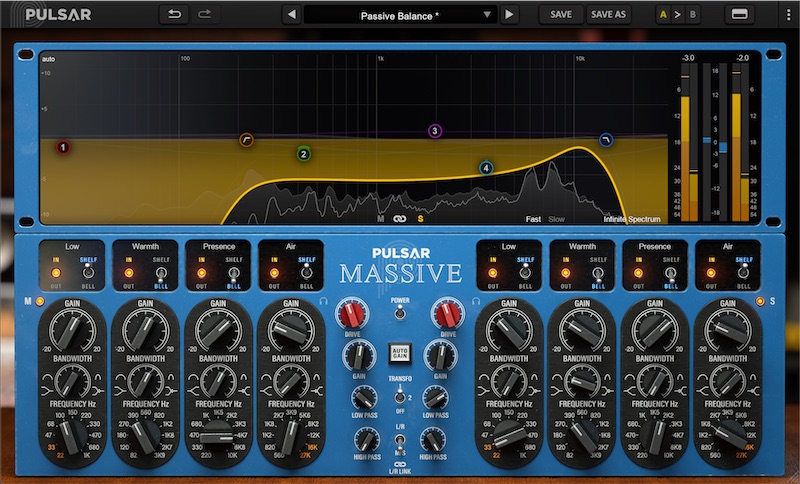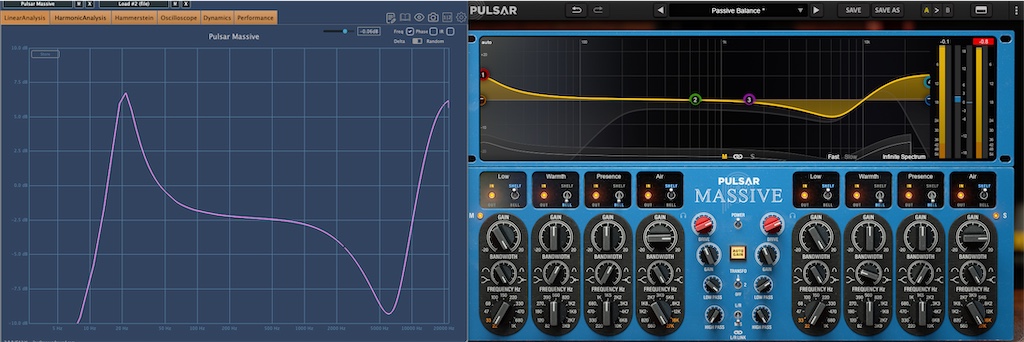The folks at Pulsar Audio kindly hooked me up with their EQ plugin Massive so I could work with it for a while and give you my thoughts. I’ve been using it in mastering as well as some mixing work for a few weeks now. Here is my review of Pulsar Massive.
Disclaimer: I only ever write about products I like. Pulsar Audio hooked me up with Massive for free so that I could get to know it and work with it for a while to do a proper review. They have no say in the content of this review. This post contains affiliate links. If you decide to buy through them, you are supporting my work.
What is Pulsar Massive?
Pulsar Massive is an emulation of one of the most famous EQ’s around – the Massive Passive.
It accurately models the original, but adds a modern feature set on top.

It’s a great EQ for situations where you want to gently shape the tonality of the material, without changing its nature too much. Common applications include mastering, vocals and drum bus or mix bus.
It’s not a surgical EQ. It can do some tighter curve shapes only in the low end. It comes with some special curves for the low and high band. These make it useful for specific tasks like boosting sub bass without affecting the upper bass region, or adding top end air without adding harshness below.
As a passive parallel design, Pulsar Massive has a gentle, natural and balanced character. Most EQ’s you’ll come across are serial design where bands will add gain on top of each other. Stacking bands in a parallel design does not result in gain adding up.
This passive topology makes for a very different band interaction compared to serial EQ’s. It can feel easier to work with for applications like mastering.
Pulsar Massive also models the tube amplifiers and inductors in Massive Passive. This means you can drive it to introduce saturation and subtle dynamic behaviour.
Saturation
Pulsar Massive can be made to sound clean or coloured, depending on how hard you drive it. You can also choose between two different types of transformer saturations, or bypassing it entirely.
I find the sound of the saturation in this plugin a very useful one. Most of the time I don’t push it. Used subtly, it can enhance the material in a nice way and make things pop better.
When you drive it harder it gets really crunchy. I don’t consider a competition for dedicated saturation plugins and I don’t like using it that way – it’s an EQ after all. But it can introduce some nice aggression to things like drums if desired.
The drive control is level compensated. This makes it easy to assess how the sound is changing.
Up to 4x oversampling is available to keep aliasing distortion at bay if needed.
Filters
The plugin is modelled precisely from the Massive Passive. The filter shapes and behaviour are a little bit unusual compared to most EQ’s out there today.
With the bell filters, the gain does not affect the bandwidth (Q) of the filter. But changing the bandwidth affects the gain. This works well for the type of work the EQ is mostly intended (broad band shaping, for example in a mastering situation).
The shelves have some interesting features where boosting one area can create a dip, followed by a boost in another area. The filters will also interact in interesting ways, creating surprising curve shapes.
The curves are wonderful for broad tone shaping work.
However, it was a really nice surprise for me to find out that there are some special shapes happening in the extreme lows and extreme highs. These areas are marked with yellow numbers in the low and air shelf bands.
The curves are all explained in the manual. But it’s really handy to have the curve display. It helps you learn how the EQ behaves and what you can do with it in different situations.

The bottom end sharp curve is great for working on the sub bass without affecting the upper bass region.
The top end curve works really well for adding air while keeping harshness at bay.
These are really nice features to have as it means you can often nail the bass as well as the top end, while doing the broad tone shaping this EQ does so well. Without these special curves I would more often be reaching for another EQ to target those areas.
Pulsar Massive is fantastic for getting a big bottom end without making things muddy. Equally it’s great for adding clarity and air in the top end without making it harsh. The usual bell and shelf filters work great for getting the overall tone of the material where it needs to be – whether it’s adding some upper mids or reducing muddyness.
Band interaction
As usual with passive EQ’s, there is interaction between the EQ bands. It makes working with the EQ unpredictable, especially when you’re still new to it. This is both good and bad.
If know I want to achieve a specific boost or cut at a specific frequency, this type of EQ is not my first choice. But if I just want to start shaping the sound, roll with it and see what happens it’s great.
Sometimes I’m not making progress with another EQ. In those situations it’s really nice to have something like Massive which can offer a different perspective.
User experience
I would argue one of the most important things in an EQ is the user experience. The choice of included features, how well they work and how they all come together in the user interface.
How does it feel to work with? Does it guide you towards a workflow that gives you good results? How fast is it to achieve what you want with it? Do you enjoy using it?
I spend a lot of time in the EQ and those things are really important to me.
Pulsar Audio have done a great job on this front. Massive offers the charm and character of an outboard device just as well as many other good faithfully modelled plugins do.
However, Pulsar Audio have still managed to include a lot of modern features and design also. The great attention to detail makes the experience of using the EQ much better. The user experience is the single main reason why I like it so much.
For me, it comes down to details like:
- Auto gain that works like it’s supposed to. Many EQ’s have auto gain. But they’re not all created equal. I don’t always use auto gain, but I usually do for tone shaping. It helps me accurately assess changes in tone, without being fooled by changes in volume.
- Level compensated drive control that goes from almost completely clean to very distorted.
- Well placed band on/off and Mid/Side solo switches.
- The ability to view and edit in classic knob mode, modern graph mode, or both.
- Stepped controls (with many options), with the ability adjust in continuous mode by right clicking on the knobs.
- The ability to enter values in text.
- A/B slots.
- Great metering (Peak+RMS and input/output difference).
- Good tooltips.
- Good manual.
- Freely resizable interface, which actually also makes the text bigger instead of just increasing the size of the window.
Many of those things seem like normal features to have in an EQ. But there are not many plugins out there that get all of it right consistently.
I really appreciate when a developer has thought about the details. It makes for a smooth user experience, which leads to better results.
The auto listen
Here follows my only complaint about Pulsar Massive. In the grand scheme of things it’s fairly minor. But because of it I’m still reaching for the Knif Soma sometimes instead.
I love that Pulsar Audio have added an auto listen (band solo) feature. But its implementation doesn’t make sense to me.
First, the auto listen only works form the curve display. You hold shift while dragging a band. That’s fine, but I often prefer to work with the curve display hidden. As far as I can tell, there is no way of using auto listen in that mode.
Second… The auto listen has a very tight Q value. As soon as you engage it, the sound gets very resonant.
That’s great for hunting resonances or other offending frequencies. For a surgical EQ I would get that. But Massive is not a surgical EQ. You can’t really target very specific spots or resonances with it (except in the lower bass region).
Paradoxically, the tight auto listen filter makes the feature useless for broad shaping work, which this EQ is really designed for. It’s very hard to “hear and think” through the resonant boost of the auto listen filter.
Why not make the auto listen follow the actual bandwidth (Q) setting that is active in the EQ? This is how it works in many other EQ’s, and it’s a much better behaviour in my opinion.
Pulsar Audio – if you are listening… Could we perhaps have an option in the settings to change the auto listen behaviour?
How does Pulsar Massive fit in to my workflow?
I have mostly been using Massive in mastering work.
I use four different types of EQ’s, depending on the situation:
- Minimum phase EQ for surgical / general work (MAAT ThEQblue).
- Linear phase EQ for phase-critical work (Weiss EQ1).
- Dynamic EQ for enhancement or solving specific problems (DMG Multiplicity / Weiss EQ1).
- Parallel EQ for overall tone shaping (Pulsar Massive / Knif Soma).
I’ve really enjoyed using Pulsar Massive for tone shaping. I am still likely to keep using Soma in certain situations. It provides a slightly different workflow that I also like and the auto listen is much better implemented.
I like using Pulsar Massive (and any other tone shaping EQ) without the graph and spectrum analyser visible. This helps me to focus on the listening. I will pop open the graph to learn about the curves though.
Trial, copy protection, system requirements
Pulsar Audio Massive uses iLok copy protection. It can be activated into the computer or on the iLok USB stick. A fully functional 14 day free trial is available.
You can check the current system requirements here.
Is Pulsar Massive worth it?
Pulsar Massive costs $149 at the time of writing this. It’s definitely on the expensive side when it comes to EQ plugins. To me, it’s also quite possibly the best product out there in its category.
I could live without it, because I already have many great EQ’s. But it’s definitely offering me something different and I have often reached really good results with it during testing.
Pulsar Massive review – Conclusion
Pulsar Massive is a really well made, professional grade tool for tone shaping work.
It sounds great. And I particularly enjoy how comfortable it is to work with. The features, user interface and attention to detail all comes together in a really nice way. My only complaint is the implementation of the auto listen feature, which feels incomplete.
It’s not an EQ for all situations. If you haven’t worked with a Massive Passive type EQ before (I hadn’t), it takes some time to begin to understand how to best use it.
The manual is good and helps a great deal in figuring it out. The included tooltips are also very useful in learning the plugin.
It’s a well rounded package and a joy to work with. It comes at a cost, but you get a lot for the money. If you’re looking for an EQ for tone shaping, Pulsar Massive has my full recommendation.

Leave a Reply